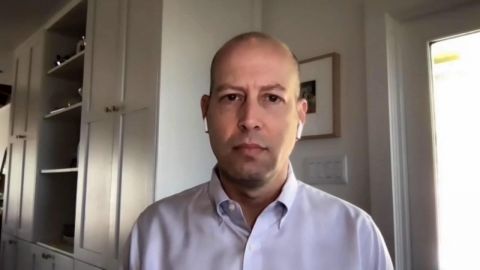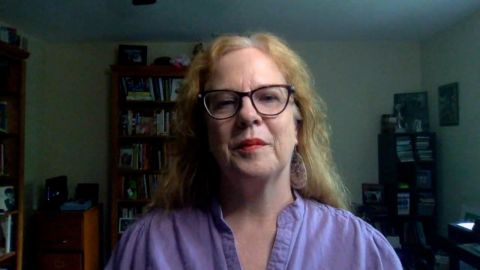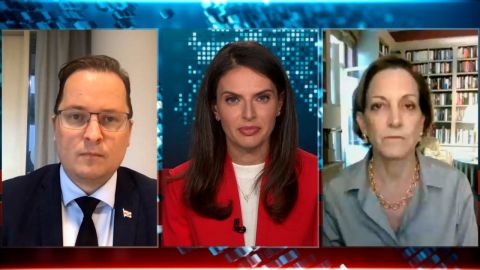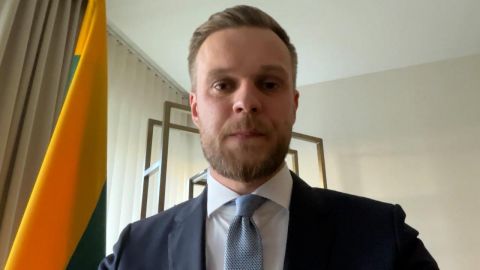Read Transcript EXPAND
BIANNA GOLODRYGA: And now, it’s not just conflict that destroys people’s homes, the climate crisis is also forcing thousands around the world to flee as their homes
become uninhabitable. Our next guest is Abrahm Lustgarten, a Pulitzer prizewinning environmental reporter. He spent years looking at how climate
migration will reshape the world. Here he is talking with our Hari Sreenivasan about his latest project.
(BEGIN VIDEO CLIP)
HARI SREENIVASAN: Briana, thanks. Abrahm, thanks for joining us. Usually, you know, when I am talking to friends and
people are — we’re having a conversation about how the world is constantly on the move, I usually say, you know, people are motivated by conflict,
cash or climate.
And conflict and cash are easy for people to understand. And you take a fascinating dive into how the world is already on the move and how that’s
going to get much more intense in the next few years, almost regardless of where you are on the planet.
ABRAHM LUSTGARTEN, SENIOR ENVIRONMENTAL REPORTER, PROPUBLICA: Yes. Thank you.
I mean, this is a project to look at migration related to climate change. And, you know, I think we talk so much about how the climate is changing in
scientific terms or ecological terms but not so much about how people experience that or how people will respond to that.
And the fact is, you know, climate determines our comfort, it determines our water supply and our food supply, and those are the drivers that lead
people to either stay where they live or to move. And all of the predictors point to really significant large-scale movement of populations in the
future and beginning now.
SREENIVASAN: Along this trail, you basically follow people as they’re leaving say Guatemala and moving north, you’re also finding how not just
impoverished but hungry people are.
LUSTGARTEN: You know, I went to Central America with a real kind of analytical mind-set. I thought that I would try to understand how migration
would stem from climate change by getting into people’s decision-making.
And I of expected, you know, we have this list of pros and cons and they’d be weighing this decision in a rationale or pragmatic way. And — you know,
and what I found was quite the opposite. That by the time someone was thinking of actually moving, of uprooting their family or leaving their
family and moving across borders, it was act of sheer desperation and it stemmed from just absolute hunger and poverty.
And, you know, the communities in Guatemala, just like elsewhere in the world, are on the edge of famine, and the potential for that famine in that
region is explosive. And one of the trades that we learn from the United Nations and others who study climate driven migration is that it’s not
usually a choice and it’s not usually a preference, it’s usually a decision of last resort, that people prefer to stay close, they’re attached to their
communities, and when they move, it’s because they have absolutely no other choice.
SREENIVASAN: Tell me a little bit about some of the people that you met along the way that were kind of the canaries in the coal mine, if you will,
of this trend that’s happening in Central America, Delmira de Jesus Cortez.
LUSTGARTEN: So, you know, when I met this woman in San Salvador and learned her story, it didn’t automatically sound like, you know, she was a,
you know, person affected by climate. She had experienced a lot of violence, her husband had been killed in a conflict with local gangs, the
Mara Salvatrucha gang is extremely influential in San Salvador and across El Salvador. That violence is normally attributed for — to driving the
migration that comes from that part of Central America to the United States.
But when you get a little bit deeper into her story, found out that she — her life is also dramatically affected by changes in climate. So, she had
come from a rural area near the Guatemalan border and El Salvador. And her family, her parents had worked as laborers in the coffee plantations that
are there. And climate had created a blight — a fungus disease that was affecting the coffee crops and coffee could no longer be grown. And the
origins of their poverty stemmed from that change, which is directly tied to climate.
They then tried to expand their farming and grow different crops, but there’s a shortage of water linked to drought, linked to change in El Nino
patterns climate, linked to climate. And those are the things that led her to migrate from her rural area into San Salvador where she then, you know,
felt prey to that gang violence and deeper into poverty.
And so, you know, this sort of exercise of learning to look, you know, beneath the, you know, layers of the various things that had influenced her
situation, to understand that, you know, climate and environmental change was as much a driving factor in her life experience and her desire to
migrate to the United States as was the violence and the things we typically, you know, attribute pressures on U.S. border to.
SREENIVASAN: What kind of numbers are we talking here? I mean, paint that picture for us and why people are so pressured to leave?
LUSTGARTEN: So, our modeling suggested, you know, about a million migrants driven — influenced at least in some way by climate out of Central America
towards the United States each year. It sounds like an extraordinary number but it’s actually close to the number of migrants we see on the border now.
It is a little bit greater than pressures that we see now.
But what’s significant is to imagine that continuing potentially growing consistently over the next 30 years. So, your cumulative impact is, you
know, 30 million or so people moving to the United States. Globally, the estimates for the number of people that will be displaced by climate are
extraordinary and they’re growing. So, you know, the United Nations counts about 30 million displaced people in 2020 alone. The World Bank estimates
about 150 million will be displaced by climate within their countries by 2050. But those numbers seem extraordinarily low.
In our analysis, we worked with researchers who had published and studied last year in the proceedings in the National Academy of Sciences that
essentially suggests one-third of the planet’s population will be faced with this decision, you know, whether to move and where to go. That study
looked at, you know, where humanity has existed for the past 6,000 years and found that we, people, live in a relatively narrow band of
environmental conditions and that band is moving for the first time, you know, in those millennium.
And as that happens, about 2 billion of today’s people, 3 billion of, you know, the population in 2070 will live outside of that zone, in places
that, you know, we would have described as unlivable. It doesn’t mean they’ll all move, but it’s very likely that a large number of them will
move. So, we’re really talking about, you know, population change on the order of billions of people.
SREENIVASAN: There are massive ripple effects on the geopolitical scale. So, let’s just stay with Central America for a second. If people uproot
themselves because they have no access to food or work and they start moving north, even before they get to the U.S. border, all of the countries
along the way are going to feel this.
LUSTGARTEN: Yes. So, I mean, movement of populations is just plain unsettling. You know, and I looked at the process, they call it, you know,
step wise migration. So, people move our rural areas, they move first to cities and they later decide to move across borders. And maybe their eyes
in that movement are on making it all the way to the United States. Maybe it’s just the goal of making it somewhere else and maybe that somewhere
else is Mexico.
And as part of my reporting, I spent significant time in Southern Mexico just looking at what was happening in their communities as thousands, tens
of thousands of migrants transited through that region. And it was really a case study, you know, in an extraordinary transformation.
Mexican people were, you know, I think at heart and philosophically, sympathetic to migrants and their goals and that changed so quickly as
those people weighed on local communities and it changed what the infrastructure could handle in terms of waste, it changed what was
available for food supply, crime rates went up. There are all sorts of pressures that just come with a large and transient population.
And that’s kind of typical and you see that around the world that the movement of people is unsettling, before they even get to their
destinations. And then, of course, you know, it can be very unsettling, you know, if not carefully planned for — at the end point of those journeys as
well, and we that, you know, today on the Southern U.S. border.
SREENIVASAN: So, should this factor into — when we think of climate policy, should we be also thinking of immigration policy or national
security as part of this formula?
LUSTGARTEN: Yes. Absolutely. I mean, the lesson that I take away from my reporting on climate in general and migration specifically is that it all
relates to one another and it has to be seen in sort of this braided fashion.
And I think you’re starting to see some of that, you know, in the Biden administration’s approach to what’s happening on the border now as well,
where, you know, it’s a very sticky and complicated issue to decide what happens, you know, with immigrants at the U.S. border, but they recognize
the importance of, you know, a multi-pronged approach where there’s an increase in aid investment and things that might, for example, help food
production down in Southern — you know, Guatemala.
And so, you know, that’s just one small example, you know, of the way that you can start to see things intertwined. But, I think, going forward, you
know, climate is a part of defense policy, it’s a part of immigration policy, it’s a part of trade, it’s a part of just about everything.
SREENIVASAN: Part two of your series was interesting in the sense that most Americans don’t think that climate migration would actually happen
here inside this country. They say, oh, yes. I understand why Central Americans would want to move up because they’re closer to the equator, et
cetera. But you lay out in painstaking detail how this is happening, and you really — let’s start talking first about the state that you’re in
right now, California.
LUSTGARTEN: Yes. I mean, I live just north of San Francisco. And, you know, we’ve had really consequential wildfires seasons the last three or
four years in a row, it’s gotten significantly worse, among many other climate pressures that — you know, that our community faces. But, you
know, it’s a real threat that I lived through it. It was a subtle threat that I thought about as I was, you know, working on this project early on.
And as my project cycle turned a year and I went through my second fire season while writing it, you know, I found myself faced with the
possibility of evacuating, faced with decision-making of, you know, is California the right place for me to live? Should I be, you know, looking
to head elsewhere in the United States? And where would that be? And realizing that that decision-making process was really a little different
from, you know, the farmers that I had — was spending time with in rural parts of Guatemala, situation.
You know, obviously, in the United States, it’s so much less extreme, our privilege, my privilege is so much greater than that, but there’s a
parallel. And, you know, what the common thread is, is that the changing environment is changing our decisions relative to our circumstances about
where we live. And if you look at the specific physical climate threats that the United States will face, again, they won’t be as severe as other
parts of the world, but they’re significant for us here.
And if you map those threats, which is what we did as part of my project, you look at sea level rise coming from the coast and hurricane pressures,
you know, along the gulf and the east coast, and the wildfires in the west and so on, places across the country that are left untouched are suggested
— are, you know, least at risk are really relatively small, and you can start to see the potential for really significant change in where Americans
live and shifting the population.
And you look a little bit deeper and start feeling that layers of that issue and you see that people are already moving. The numbers are small-
ish, but they’re getting bigger.
SREENIVASAN: There’s also an increased urbanization, you know, of these projections, that big cities are going to get bigger.
LUSTGARTEN: So, this is a pattern that we see worldwide and is going to characterize the change that we see in the United States as well. People
move out of rural areas and towards cities and seek the services that those cities can provide.
And I think that, you know, what’s beginning to happen in the United States and what I see, you know, happening over the next couple decades is that
rural areas or even small communities, small municipalities, you know, will not have everything from, you know, the capital, the tax base that they
need, the human capital and expertise to guide transition, to build resilience, to invest in, you know, mitigation measures that are going to
be required to, you know, confront the change that they face.
And, you know, as that happens, people will increasingly find those services in concentrated areas, which mean big cities.
SREENIVASAN: You know, you point out in the piece acutely that there will be projected water shortages West of Missouri, and on the other hand, there
will be too much water along the coasts. I mean, we have to kind of find sort of a goldilocks zone where there’s enough water to drink and at the
same time it’s not drowning us.
LUSTGARTEN: Yes. Absolutely. I mean, water is fascinating in terms of climate change, both for, you know, the scarcity that we will all face in
terms of fresh water and, you know, usable water for drinking, for example. But also, the way in which climate change will, you know, not just bring
sort of what everybody thinks of as, you know, heat and drought, but will bring greater extremes.
You know, we talked about these mega rain events, you know, in the northern part of the Midwest that if it just increasing in frequency the last couple
years, they’ve led to lake levels of the great lakes, Lake Michigan, to rise, you know, about a foot a year. It’s faster than sea level rise on the
coast. And all of our focus goes to, you know, sea level rise as, you know, the icecaps melt, but we have, you know, lake level rise, you know, that’s
just as significant.
You know, I think the bottom line is that climate is going to change everywhere, you know, Americans and people around the world are going to
need to figure out how to mitigate that where they can, retreat where they need to, you know, and adapt to those changing circumstances.
And, you know, it’s going to be on a sliding scale where in some places, adaptation might mean that a place becomes unlivable and you have to move.
You know, maybe I don’t want to live in, you know, a wildfire zone. But in other places, you know, adaptation might mean a much more subtle
adjustment. But few places will be untouched.
SREENIVASAN: When you look at policies, I mean, the U.S. refused to join 164 other countries in signing a migration treaty in 2018. At the same
time, the U.S. has cut back on aid that would help some of families who are struggling right now. So, what should the Biden administration do?
LUSTGARTEN: I mean, I — you know, I think the lesson for me through all this research is that, you know, the more that’s done in a very multi-
facetted and diverse way and the faster that it’s done, the better. So, I guess what that means is they should do everything and do it quickly.
But, you know, my bias which, you know, is a result of our modeling and extraordinary amount of research is that, you know, more open borders, more
receptive policies have a positive net result, they improve, you know, security and stability for the United States or for, you know, developed
countries and they improve livelihoods and stability of origin countries.
And I mean, you can see that in a number of examples. And Syria is one that comes up frequently where, you know, there’s roots to the Syrian conflict,
you know, a decade ago in the same environmental change where you — you know, you saw, you know, pastoral communities having a difficult time
raising their animals. And so, they rapidly urbanize and that urbanization led to pressures that led to — you know, or at least contributed to, you
know, the uprising there.
Nations faced a decision then, Europe, about, you know, what kind of aid to provide and how to, you know, help address the drought that Syrians were
facing, and they chose not to. You know, I think that’s a cautionary tale for what we do going forward. You know, and so, again, that foreign aid is
an option and I would like to see, you know, our administration and modern administrations, you know, take that route, you know, and do pragmatic,
manageable controlled but open border policies, I think, you know, are necessary to allow a sort of healthy flow around the world.
I mean, after all, like, you know, migrations always happen and it always will. In any sense, it’s a very natural adaptation to our environments
around us and, you know, borders are a modern construct that, you know, prohibit that from happening.
SREENIVASAN: Abrham Lustgarten, thanks so much for joining us.
LUSTGARTEN: Thanks so much for your interest. I appreciate it.
About This Episode EXPAND
Over the weekend, many Gazans got their first real look at the devastation brought by the 11 days of bombardments. And now begins the daunting, familiar task of rebuilding.
LEARN MORE



